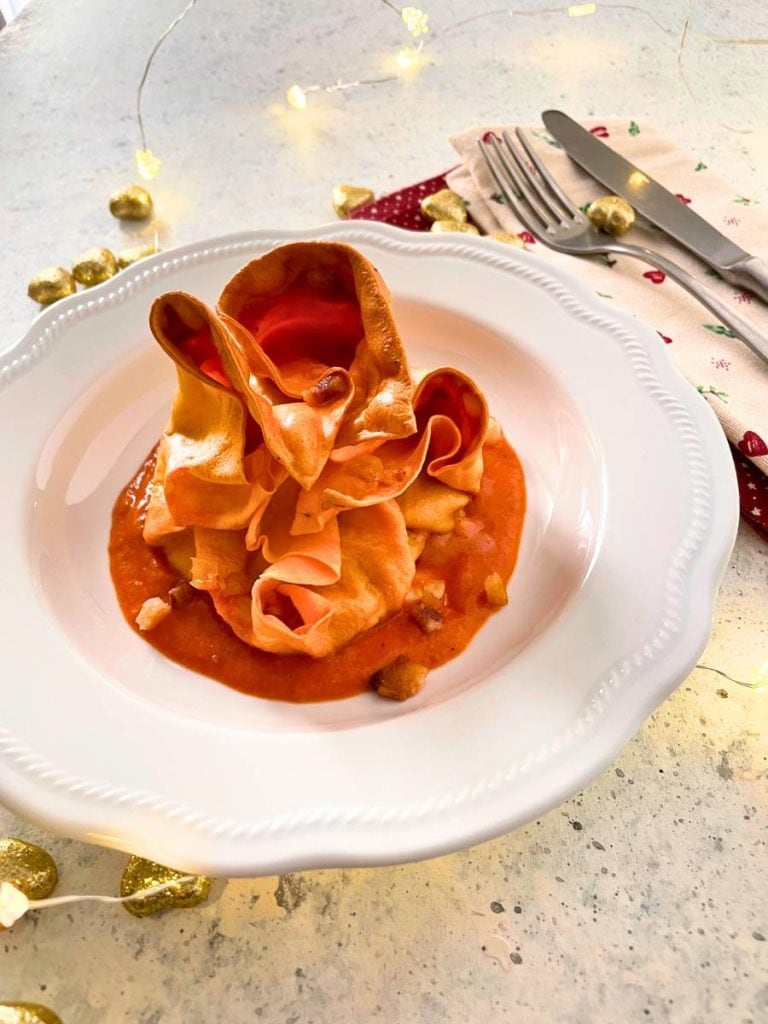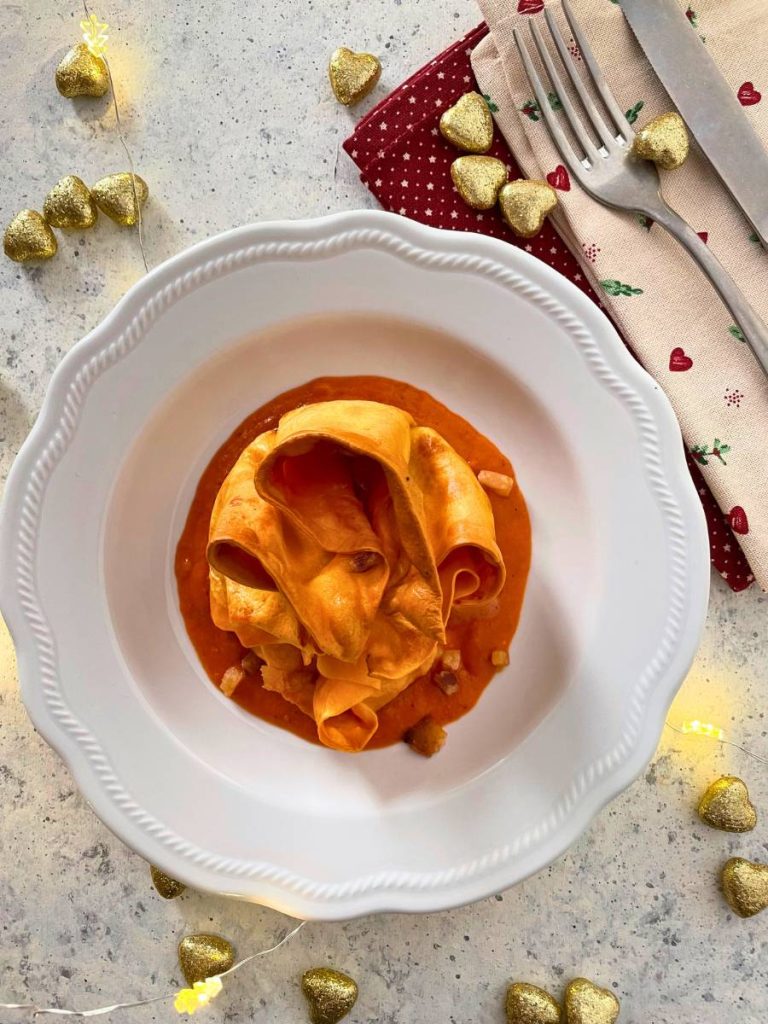The crispy Amatriciana lasagnetta is an alternative version of the classic Amatriciana pasta. The ingredients are the same, with the only addition of béchamel sauce because the lasagnetta is baked in the oven, only the shape changes.
This recipe is from Chef Marco Bartolomei who guided us step by step in its creation during the online cooking evening organized by the Chamber of Commerce of Rieti and Viterbo and Azienda speciale Centro Italia within the “Tourism and Culture” framework. If you remember, I already showed you the recipe for ‘mbriachelle and gnocchetti in frasca.
It’s a slightly complex recipe, but still simple in its execution, with just a few steps to achieve the desired result. However, you will see that it will be worth it, the taste of the crispy Amatriciana lasagnette is delicious.
In this recipe, we used two products from Amatrice, guanciale and pecorino from the Monti della Laga, two typical products from the upper Lazio region that were sent to us specifically for the recipes of the project.

- Difficulty: Medium
- Cost: Medium
- Rest time: 30 Minutes
- Preparation time: 1 Hour
- Portions: 6 servings
- Cooking methods: Oven
- Cuisine: Italian
- Seasonality: Fall, Winter, and Spring
- Energy 623.79 (Kcal)
- Carbohydrates 48.28 (g) of which sugars 7.27 (g)
- Proteins 16.96 (g)
- Fat 39.91 (g) of which saturated 17.57 (g)of which unsaturated 19.56 (g)
- Fibers 2.84 (g)
- Sodium 648.41 (mg)
Indicative values for a portion of 300 g processed in an automated way starting from the nutritional information available on the CREA* and FoodData Central** databases. It is not food and / or nutritional advice.
* CREATES Food and Nutrition Research Center: https://www.crea.gov.it/alimenti-e-nutrizione https://www.alimentinutrizione.it ** U.S. Department of Agriculture, Agricultural Research Service. FoodData Central, 2019. https://fdc.nal.usda.gov
Ingredients for the Amatriciana Lasagnetta
- 2 1/2 cups all-purpose flour
- 3 eggs
- 1 tbsp tomato paste
- 1 pinch salt
- 7 oz guanciale (from Amatrice)
- 2 cups peeled tomatoes
- 2 cups milk
- 3 1/2 tbsp butter
- 1/3 cup all-purpose flour
- 1 3/4 oz pecorino cheese (from Monti della Laga or Amatrice)
- 1/2 glass dry white wine
Tools
- Pasta Roller
- Baking Cups
Preparation of the Amatriciana Lasagnetta
Pour the flour into a bowl, make a well and break the eggs in the center. Start mixing with a fork, gradually incorporating the flour. Add the tomato paste and continue kneading. When the dough starts to detach from the sides of the bowl, turn it onto a work surface and continue kneading with your hands until smooth. Cover it with plastic wrap and let it rest for half an hour.
Meanwhile, prepare the Amatriciana sauce. Cut the guanciale into strips and place it in a large pan, letting it “sweat” over low heat. Do not add oil, just be patient. As it cooks, it will release its fat and become crispy, which will take about 10 minutes.
Remove a couple of tablespoons of crispy guanciale and set it aside for the final garnish.
Deglaze with the white wine, let it evaporate, then add the crushed peeled tomatoes. Let the sauce cook for about 10-15 minutes until it is nice and thick.
Prepare the béchamel sauce. Melt the butter in a saucepan and add the flour, stirring quickly until it turns nut-brown. Gradually pour in the warm milk, continuing to stir to avoid lumps. Add a pinch of salt and continue cooking until the sauce is creamy and thick. Once ready, remove from heat and let it cool slightly.
Set aside a little of the prepared Amatriciana sauce, trying to take less guanciale and more tomato sauce, you will need it for the base of the dish.
Add the béchamel sauce to the Amatriciana sauce and mix carefully. This will be the filling for the lasagnetta.
Take the dough and roll it out thinly; I used a pasta machine and passed it on the last number.
Cut out squares of 6 inches per side and boil them in lightly salted water with a drop of extra virgin olive oil.
As soon as the squares float to the surface, remove them with a slotted spoon and plunge them into a bowl with cold water. After a few minutes, lay the sheets out on a clean cloth to dry.
Continue this way with all the dough you have. You will get about 12 squares and some scraps that also need to be boiled, as they will be used to make the layers inside the lasagnette.
Cut out 12 squares of dough about 2 inches wide from the scraps and set them aside.
Butter the aluminum baking cups and grate the pecorino cheese.
Place the sheets on the work surface and place a generous spoonful of filling in the center. Cover with a 2-inch square and add another spoonful of filling. Top with a little grated pecorino and place the sheets with their filling in the baking cups, bringing the edges together to form a small bundle.
Bake the Amatriciana lasagnette in a preheated oven at 320°F for 15 minutes.
Meanwhile, prepare the Amatriciana cream.
Take the sauce you set aside and dilute it with a little pasta cooking water, mix carefully, and pour it into the immersion blender jar. Blend well to obtain a smooth and uniform mixture. Keep warm.
As soon as the lasagnette are cooked, proceed with plating.
Pour a spoonful of cream on the bottom of individual plates and place a lasagnetta in the center, decorating with a little crispy guanciale.
Serve immediately.

Follow me on social media
my Facebook page, my Instagram profile, my Pinterest page
FAQ (Questions and Answers)
What is Amatriciana guanciale?
It is a raw cured meat obtained from the pig’s cheek, between the head and the shoulder, with a characteristic triangular shape, covered with various spices, including pepper and chili. The processing follows traditional methods; the guanciale is salted for 4 or 5 days, then washed and seasoned before being left to rest for 30 days at 50-59°F with smoking. It is then aged for at least 2 months.
History
Amatriciana guanciale has a strong connection with the high Velino valley. It was an integral part of the diet of the shepherds of the Monti della Laga, being easy to preserve and providing good caloric intake during the months spent in the mountains. Together with Pecorino, it was originally the only pasta condiment.What is pecorino from the Monti della Laga?
This fatty hard cheese is made with mixed sheep and goat milk (goat milk not exceeding 30%), characterized by a slightly salty and slightly spicy flavor. The aging can vary from 3 to 6 months. It is typically produced in the Amatrice area, where it is used as a basic ingredient for Gricia and Amatriciana and is recognized by the Lazio Region as a Traditional Food Product (PAT).
History
Pecorino has represented for centuries the basis of the diet of shepherds moving with the flocks between Puglia, Abruzzo, and Lazio, in constant search of pastures that would then give the products almost unique aromas and fragrances. Its organoleptic characteristics, as well as the processing methods, are passed down from generation to generation.

